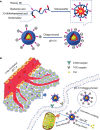pH-Responsive Polymer Nanomaterials for Tumor Therapy
- PMID: 35392227
- PMCID: PMC8980858
- DOI: 10.3389/fonc.2022.855019
pH-Responsive Polymer Nanomaterials for Tumor Therapy
Abstract
The complexity of the tumor microenvironment presents significant challenges to cancer therapy, while providing opportunities for targeted drug delivery. Using characteristic signals of the tumor microenvironment, various stimuli-responsive drug delivery systems can be constructed for targeted drug delivery to tumor sites. Among these, the pH is frequently utilized, owing to the pH of the tumor microenvironment being lower than that of blood and healthy tissues. pH-responsive polymer carriers can improve the efficiency of drug delivery in vivo, allow targeted drug delivery, and reduce adverse drug reactions, enabling multifunctional and personalized treatment. pH-responsive polymers have gained increasing interest due to their advantageous properties and potential for applicability in tumor therapy. In this review, recent advances in, and common applications of, pH-responsive polymer nanomaterials for drug delivery in cancer therapy are summarized, with a focus on the different types of pH-responsive polymers. Moreover, the challenges and future applications in this field are prospected.
Keywords: drug delivery; nanomaterials; pH-responsive polymer; tumor; tumor microenvironment.
Copyright © 2022 Chu, Shi, Tian and Gao.
Conflict of interest statement
The authors declare that the research was conducted in the absence of any commercial or financial relationships that could be construed as a potential conflict of interest.
Figures






Similar articles
-
Tumor microenvironment-responsive hyperbranched polymers for controlled drug delivery.J Pharm Anal. 2024 Dec;14(12):101003. doi: 10.1016/j.jpha.2024.101003. Epub 2024 May 22. J Pharm Anal. 2024. PMID: 39831051 Free PMC article. Review.
-
A critical review on the dissemination of PH and stimuli-responsive polymeric nanoparticular systems to improve drug delivery in cancer therapy.Crit Rev Oncol Hematol. 2023 May;185:103961. doi: 10.1016/j.critrevonc.2023.103961. Epub 2023 Mar 13. Crit Rev Oncol Hematol. 2023. PMID: 36921781 Review.
-
Stimuli-Responsive Polymer-Based Nanosystems for Cancer Theranostics.ACS Nano. 2023 Dec 12;17(23):23223-23261. doi: 10.1021/acsnano.3c06019. Epub 2023 Dec 2. ACS Nano. 2023. PMID: 38041800 Review.
-
Tumor Microenvironment-Responsive Nanomaterials as Targeted Delivery Carriers for Photodynamic Anticancer Therapy.Front Chem. 2020 Sep 29;8:758. doi: 10.3389/fchem.2020.00758. eCollection 2020. Front Chem. 2020. PMID: 33134254 Free PMC article. Review.
-
Recent Progress in Stimuli-Responsive Intelligent Nano Scale Drug Delivery Systems: A Special Focus Towards pH-Sensitive Systems.Curr Drug Targets. 2021;22(8):947-966. doi: 10.2174/1389450122999210128180058. Curr Drug Targets. 2021. PMID: 33511953 Review.
Cited by
-
Harnessing the Power of Nanocarriers to Exploit the Tumor Microenvironment for Enhanced Cancer Therapy.Pharmaceuticals (Basel). 2025 May 19;18(5):746. doi: 10.3390/ph18050746. Pharmaceuticals (Basel). 2025. PMID: 40430563 Free PMC article. Review.
-
Biodegradable and Inherently Fluorescent pH-Responsive Nanoparticles for Cancer Drug Delivery.Pharm Res. 2022 Nov;39(11):2729-2743. doi: 10.1007/s11095-022-03317-8. Epub 2022 Jun 28. Pharm Res. 2022. PMID: 35764754 Free PMC article.
-
Multifunctional nanocomposites modulating the tumor microenvironment for enhanced cancer immunotherapy.Bioact Mater. 2023 Sep 6;31:440-462. doi: 10.1016/j.bioactmat.2023.08.022. eCollection 2024 Jan. Bioact Mater. 2023. PMID: 37701452 Free PMC article. Review.
-
ULK1 Mediated Autophagy-Promoting Effects of Rutin-Loaded Chitosan Nanoparticles Contribute to the Activation of NF-κB Signaling Besides Inhibiting EMT in Hep3B Hepatoma Cells.Int J Nanomedicine. 2024 May 18;19:4465-4493. doi: 10.2147/IJN.S443117. eCollection 2024. Int J Nanomedicine. 2024. PMID: 38779103 Free PMC article.
-
Engineering Stimuli-Responsive Materials for Precision Medicine.Small. 2025 Jan;21(1):e2406439. doi: 10.1002/smll.202406439. Epub 2024 Oct 23. Small. 2025. PMID: 39444066 Free PMC article. Review.
References
Publication types
LinkOut - more resources
Full Text Sources

